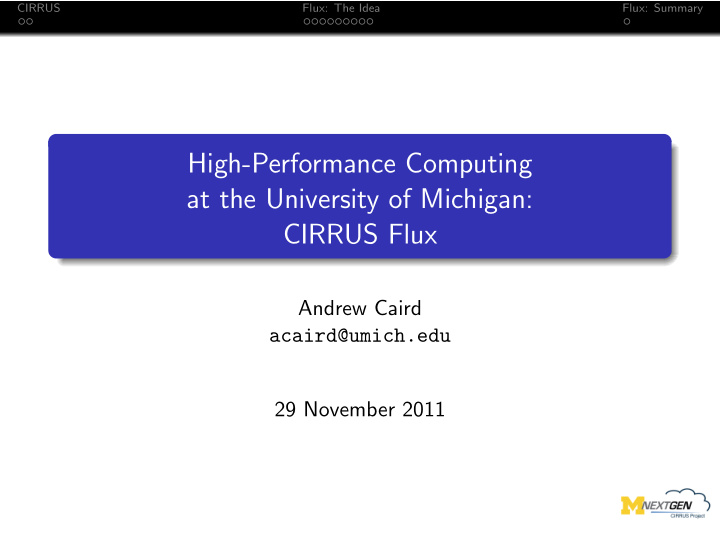



CIRRUS Flux: The Idea Flux: Summary High-Performance Computing at the University of Michigan: CIRRUS Flux Andrew Caird acaird@umich.edu 29 November 2011
CIRRUS Flux: The Idea Flux: Summary CIRRUS: Flux CIRRUS is a coordination of U-M resources: CIRRUS Flux 29 nov 11 Researchers Graduate Students Co-curricular Projects Undergraduates Courses External Collaborators acaird CIRRUS Research Computing Service Experience in Supported Process and Computing User Support Software Data Storage Governance Research Computing Rate to Buy Access Hardware Departmental Hardware Operations Better than Short-term Can Support UMDearborn LSAIT MSIS Policy Direction IT Staff and Development a Desktop Storage Your Storage Office of Research High-speed No Backed-up No Archival CAEN Cyberinfrastructure Storage Storage Storage (ORCI) Rest of Medical School College of ITS LSA OVPR Campus Health System Engineering Ordering and Datacenter Rate Billing Provisioning Operations
CIRRUS Flux: The Idea Flux: Summary CIRRUS Computing and Information Resources for Research as a Utiliy Service We want people to do computing without worrying too much about the computers.
CIRRUS Flux: The Idea Flux: Summary Flux: the concept The Flux Project endeavors to provide cluster, data-intensive, and next-step computing to U-M researchers. The Flux Project aggregates demand and fulfills it in an efficient way for you; it is a set of policies for providing HPC: cores are allocated in increments of 1, the number of which can be increased or decreased every month there is no hardware ownership, everything is allocations from an existing pool of hardware the hardware is held as homogeneous as possible: similar CPUs, memory-to-core ratios, networking capability
CIRRUS Flux: The Idea Flux: Summary Flux: the paperwork The Flux Project is currently based on two-dimensional allocations: a number of cores for a number of months The usage of the Flux Cluster is billed monthly: billed for allocation, not usage no “roll-over”, so all commitments can be honored can be changed every month (really, any day during the month)
CIRRUS Flux: The Idea Flux: Summary Flux: the hardware 4,000 cores in 339 computers Per computer: dual 6-core Intel Xeon X5650 CPUs at 2 . 67GHz; 48 GB RAM Quad Data Rate (QDR) Infiniband per node: 40Gbps, ∼ 4 µ s latency 375 of scratch space : 4 hosts, 48 CPUs, and 180 hard drives 8 NVIDIA M2050 General Purpose Graphics Processing Units (GPUs) 10GbE data transfer connection (soon to include U-M Dearborn)
CIRRUS Flux: The Idea Flux: Summary What Flux is good at A traditional HPC environment, like Flux, is good at computational problems that have certain properties: explicitly parallel jobs: many-core MPI programs “trivially” parallel jobs: many single-core tasks long-running serial jobs: so you can turn off your laptop jobs with large data sets: larger than your laptop can hold
CIRRUS Flux: The Idea Flux: Summary What Flux is good at In addition to being a nice implementation of a traditional HPC environment, Flux has a few other nice properties: it is local : in network, support, physical, and philosophical senses it is dynamic: researchers can start small and scale up and down as their needs or budget dictate
CIRRUS Flux: The Idea Flux: Summary What Flux is being used for On 25 October 2011, Flux has 72 different research groups using it. Three examples of its use are: Center for Radiative Shock Hydrodynamics (CRASH) is improving the ability to do predictive simulations of high energy-density flows Dr. Abecasis in Public Health is developing the computational and statistical tools required for understanding human genetic variation, with a particular focus on complex human disease Dr. Mebane in Political Science is studying Election Forensics, which aims to develop statistical and computational tools for detecting anomalies and diagnosing fraud in election results
CIRRUS Flux: The Idea Flux: Summary What Flux is not good at For all its nice properties, Flux is not ideal for everything. Among those are: programs or projects with significant graphics requirements interactive use running non-Linux programs
CIRRUS Flux: The Idea Flux: Summary Flux: Software three compilers (Gnu(2), Intel(3), PGI(5)), MPI library (OpenMPI (3 × ∼ 4)) Commercial parallel debugger (DDT) and profiler (OPT) 102 other packages, about 40% commercial, 60% locally compiled Colleges, Schools, or Departments can add their own software; LSA and the Medical School are doing this today.
CIRRUS Flux: The Idea Flux: Summary The Process To use Flux, it’s best to start by reading http://www.engin.umich.edu/caen/hpc/planning/ or contacting flux-support@umich.edu to talk about the needs and the suitability of Flux. After that your local Flux Support person will need to know: the number of cores in the allocation the duration of the allocation in months the list of allowed users for the project a valid shortcode we can charge each month Once we have that information it is a matter of hours to make the allocation.
CIRRUS Flux: The Idea Flux: Summary Flux: All you need to know Many cores, many Terabytes, many Gigabits per second Lots of software, and more if you want it Excellent local support from staff in your lab, department, school, college, University Affordable monthly bills of $18/core ($11.20/core until July 2012) ⇒ flexibility and control flux-support@umich.edu http://www.engin.umich.edu/caen/hpc
Recommend
More recommend